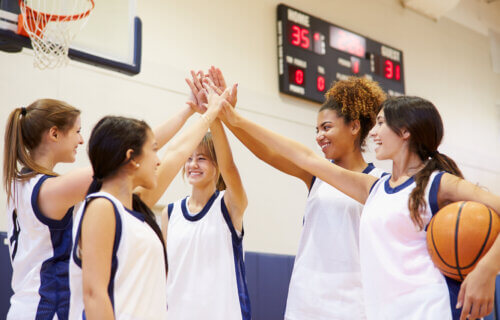BASEL, Switzerland — The clock is ticking down in a crucial basketball game. The score is tied. A player steps up to the free throw line, the fate of the game potentially resting on her shoulders. She takes a deep breath, dribbles the ball a few times, and shoots… but the ball rims out. Miss. As she turns back to her teammates, one reaches out and gives her a quick pat on the shoulder. A simple gesture, over in a second. But could that fleeting touch actually affect what happens next?
According to a fascinating new study published in Psychology of Sport and Exercise, the answer is yes. Researchers from the University of Basel in Switzerland, the University of Kaiserslautern-Landau in Germany, and Purdue University in the United States analyzed hundreds of free throw situations from women’s college basketball games. They were interested in what happened between pairs of free throws – specifically, how many teammates touched the shooting player after the first shot and whether that seemed to influence the likelihood of making the second shot.
The findings were striking. When a player missed the first free throw, the number of teammates who reached out to touch her – a hand on the shoulder, a pat on the back – predicted her success on the second shot. The more teammates who offered that quick physical connection, the greater the chances she’d sink the next one.
This effect held up even after accounting for a range of other factors that might influence free throw success, like the player’s individual skill level, whether the team was playing at home or away, the point difference in the game at the time, and how much time was left on the clock. None of those contextual factors seemed to matter as much as the simple act of touch from teammates.
Notably, the power of touch was most evident after a miss on the first shot. When players made their first free throw, the pats and high fives that followed didn’t seem to make much difference either way. It was specifically when players were likely feeling the sting of failure and the pressure of the moment that the supportive touch seemed to count.

So what’s going on here? How can a momentary physical connection carry so much weight? The researchers suspect it has to do with what that touch conveys. A hand on the shoulder from a teammate is a powerful nonverbal signal of support, encouragement, and solidarity. It’s a way of saying, “We’re with you, even when you miss.”
Past research has shown that these kinds of supportive touches can reduce stress and anxiety, both physically and psychologically. In high-stakes, high-stress situations – like shooting a free throw with the game on the line – that soothing effect might be especially impactful. A warm touch from a teammate could serve as a critical emotional reset, a reminder to take a breath and refocus.
The study’s authors note that their findings align with a growing body of research on the profound interpersonal effects of touch. Even fleeting physical contact has been shown to foster trust and cooperation, to signal empathy and care. In the context of a team sport, those bonds and that sense of support might be the secret sauce that allows players to perform their best under pressure.
There may even be concrete physiological mechanisms at play. Some studies have linked supportive touch to reduced levels of cortisol, a primary stress hormone. Elevated cortisol, in turn, has been tied to diminished athletic performance. So, in the same way that a coach’s massage might help an athlete shake off stress and tension, a teammate’s pat could have a real, body-level impact in the crunch.
The researchers are careful to note the limitations of their study. They focused on women’s college games, so it’s an open question whether the same dynamics would play out for men or for professionals. The findings are also correlational – the touchier teams might be more successful for other reasons, like overall cohesion and chemistry. But the trends are compelling enough to suggest that teams might want to take note. Encouraging those little moments of connection and support could pay real dividends when the pressure is high.
More than anything, this study is a powerful reminder of just how much we communicate through touch – and how much those wordless connections matter, on the court and off. So next time you see a player miss a critical free throw, keep your eye on what happens next. That hand on her shoulder might just make all the difference.
